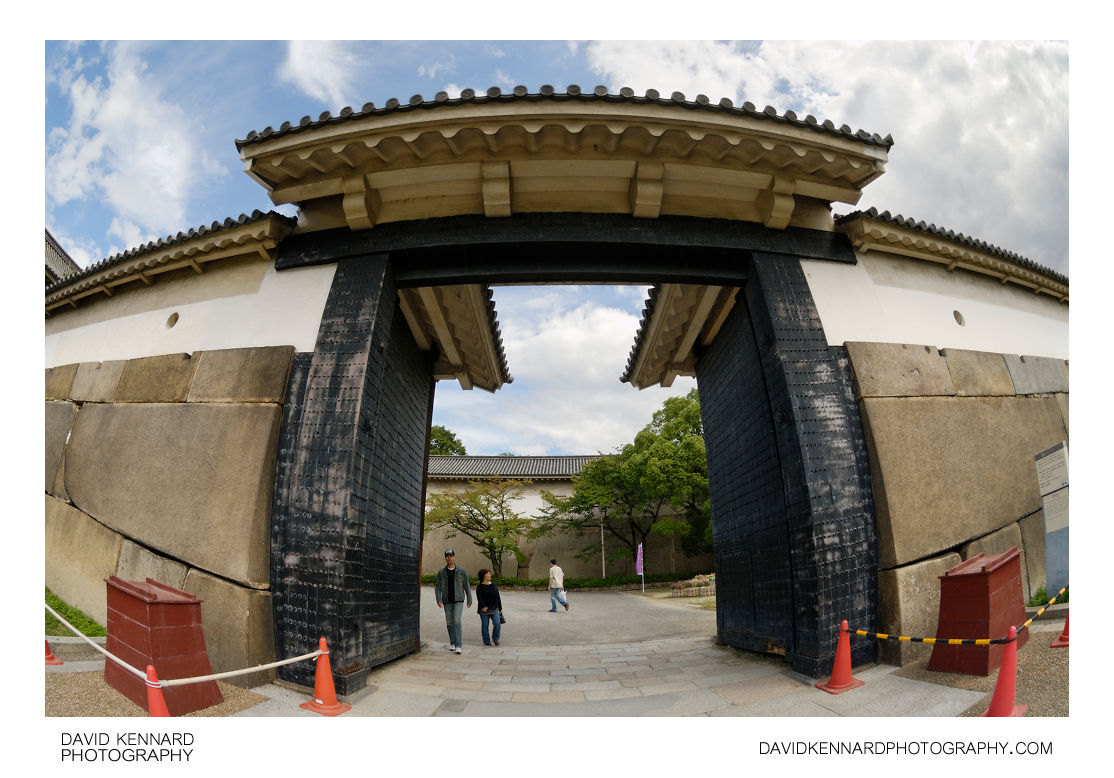Ōte-Mon gate, Osaka Castle

Description
- Title:
- Ōte-Mon gate, Osaka Castle
- Caption / Description:
-
Ote gate (大手門; Ōte-Mon), the front gate of Osaka Castle (大坂城; 大阪城; Ōsaka-jō). The gate was originally constructed in 1628 as part of the castle improvements and reconstruction ordered by the Shogun Tokugawa Hidetada. Ōte-Mon was built with thick iron doors to prevent damage from weapons, and has been designated an Important Cultural Asset of Japan.
Osaka Castle was originally constructed in 1583 by Toyotomi Hideyoshi on the previous site of Ishiyama Hongan-ji, which was destroyed in by Toyotomi's predecessor Oda Nobunaga in 1580. In 1614 the castle was attacked by Tokugawa Ieyasu, who had the outer moat filled in. Later in 1615 Tokugawa returned and took the castle.
In 1620 Tokugawa Hidetada, the successor to Tokugawa Ieyasu, began to reconstruct Osaka Castle. The large stone block walls of the castle date from this period. By 1843 the castle had fallen into disrepair, and repairs were carried out using money collected from the people of the region.
During the Meiji restoration in 1868 the castle fell to the Imperial forces, and was converted to a military barracks by the new government. Due to its military use it was targeted by American air raids during World War II and suffered heavy damage. Since the war some buildings have been restored, and the castle is today a popular tourist attraction.
- Tags / Keywords:
-
- Asia
- Japan
- 日本国
- Nihon-koku
- Kansai region
- 関西地方
- Kansai-chihō
- Osaka prefecture
- 大阪府
- Ōsaka-fu
- Osaka city
- 大阪市
- Ōsaka-shi
- Kinki region
- 近畿地方
- Kinki-chihō
- Chuo-ku
- 中央区
- Osaka Castle
- 大坂城
- 大阪城
- Ōsaka-jō
- Ote gate
- 大手門
- Ōte-Mon
Admin
- Date Original Photo Taken:
- Original File Name:
- Otemon gate.psd
- Event:
- Rating:
- ☆
- Date this image added/last updated on website:
- Original File Dimensions:
- 3826px x 2529px
- File Type:
- JPEG
- Color Mode:
- Original Image Color Profile:
- Nikon Adobe RGB 4.0.0.3001
Location
- Location Shown:
-
- Sublocation:
- Osaka Castle
- City:
- Osaka
- Province/State:
- Osaka prefecture
- Country:
- Japan
- World Region:
- Asia
- Location Created:
-
- Sublocation:
- Osaka Castle
- City:
- Osaka
- Province/State:
- Osaka prefecture
- Country:
- Japan
- World Region:
- Asia
- Geo-location:
- 34.685041666667, 135.52303166667 View on map
Rights
- Copyright Status:
- Copyrighted
- Licensing Status:
- Rights Managed
- Available for Editorial Use:
- Yes
- Available for Commercial Use:
- No
- Copyright Notice:
- © 2009 Dave Kennard
Camera Data
- Date Digital Resource was created:
- Shutter speed:
- 1⁄80 s
- Aperture:
- f/8
- Camera Model:
- Nikon D200
- ISO:
- 100
- Exposure Compensation:
- 0
- Focal Length:
- 10mm
- Focal Length (35mm equiv.):
- 15mm
- Metering Mode:
- Multi-segment
- Flash:
- No Flash
- Exposure Mode:
- Auto
- White Balance:
- Manual
- Light Source:
- Cloudy
- Exposure Program:
- Aperture-priority AE
Additional shooting metadata
- Lens:
- Tokina ATX107 DX FishEye 10-17mm F3.5-4.5
- Filters used:
- Additional Optics used:
- Setup:
- Handheld, bracketed ±1EV
Post Processing
- Image Modified:
- Software used:
-
- Nikon Capture NX 2
- Adobe Photoshop CS5
- Post Processing:
NEFs converted with -0.3 exposure compensation in CNX2
Images blended for exposure in PS CS5
Topaz Adjust 4 using Photo Pop preset applied in PS CS5
